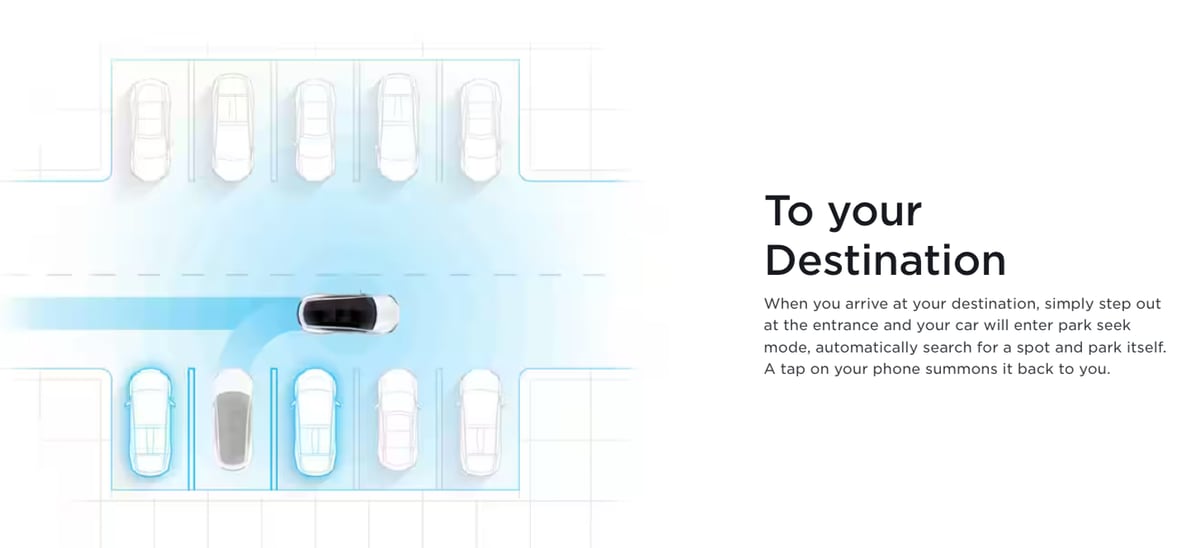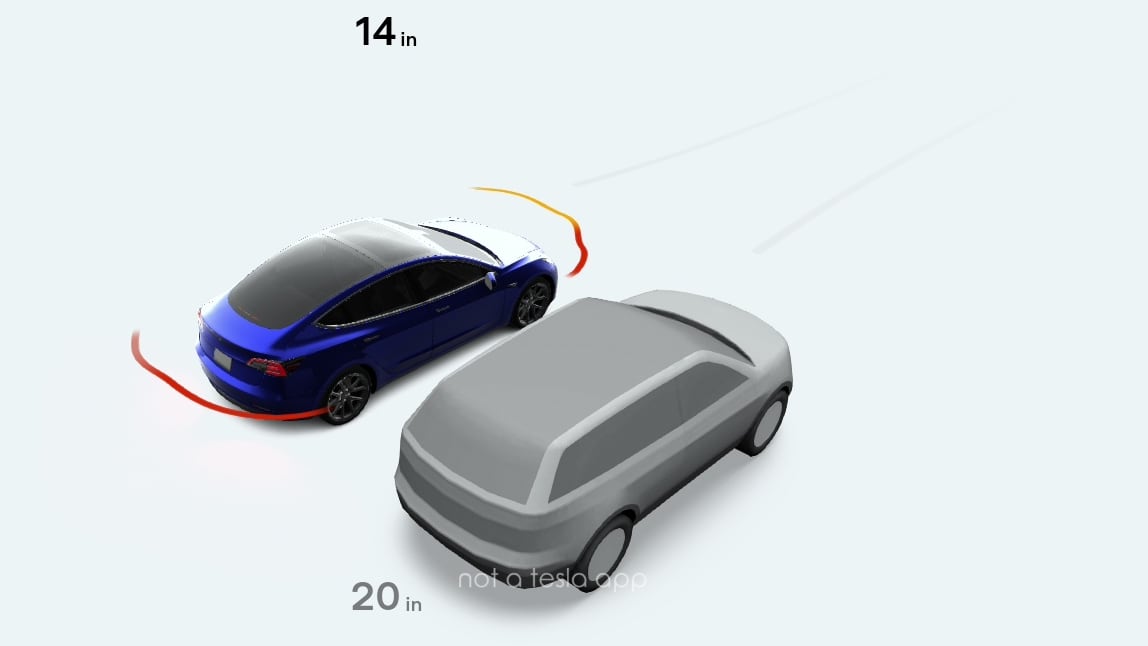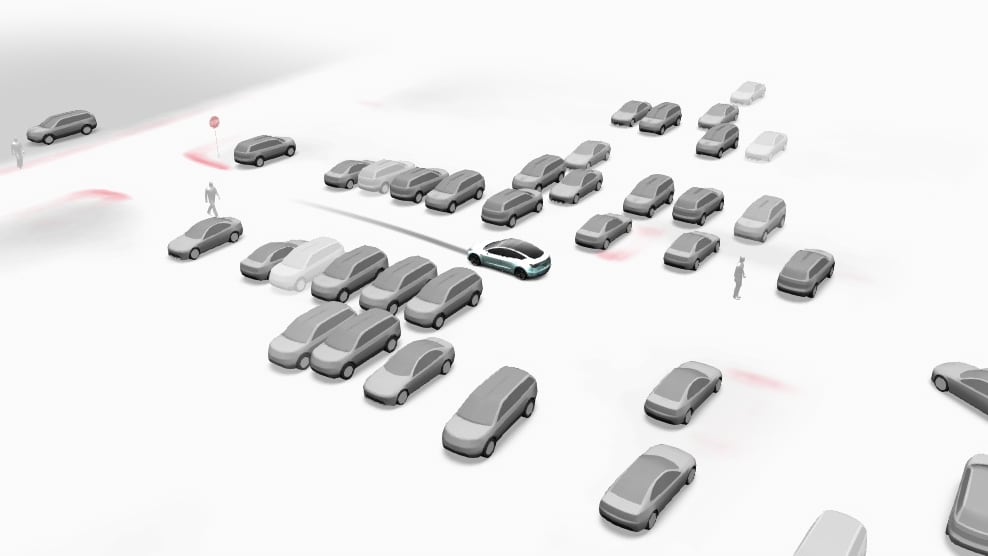Future Feature
By Kevin Armstrong

Tesla's team of Autopilot engineers is validating significant advancements to Full Self Driving Beta, including parking lot improvements. While Smart Summon and Reverse Summon were not specifically mentioned during the 3.5-hour AI Day 2022 event, parking lots were discussed, and Elon Musk gave a timeline of when enhancements are expected.
Reverse Summon or 'Park Seek' as Tesla appears to be calling it, is the opposite of Smart Summon. Whereas Smart Summon drives to you from a parking spot, users who activate Reverse Summon would have their Tesla drop them off at a location, perhaps closest to the entrance of a mall, and then find a parking spot. This feature was described by Musk on July 1, 2020, when he gave it a two to a four-month timeline.
Ashok Elluswamy, Tesla’s director of the Autopilot program, started the FSD portion of AI Day, saying, “FSD beta software is quite capable of driving the car. It should be able to navigate from parking lot to parking lot, city street driving, stopping for traffic lights and stops signs, negotiating with objects at intersections, making turns and so on.”
Several team members described how FSD has advanced and soon will be an integrated stack, meaning one code base that includes everything the program needs to navigate the car in a parking lot or on a busy highway. Musk is currently using this new stack, “it works quite well for me, but we need to validate it in all kinds of weather, like heavy rain, snow, dust and make sure it is working better than the production stack across a wide range of environments.”
Paril Jain, the Manager of Autopilot Motion Planning, expanded on what else will be included in the integrated stack, “we do expect to also include the parking lot stack as a part of the FSD stack before the end of this year. So, that will basically bring us to you sitting in the car in the parking lot and drive till the end of the parking lot, at a parking spot, before the end of this year.”
It has been previously reported that Reverse Summon would have three different modes to find parking spots that the owner prefers. The methods would include closest to the entrance, nearby a cart return, and the end of the parking lot for those who like to avoid tight spots that cause door dings. Musk said that the integrated stack is on track for release before the end of the year and maybe as early as November.
Tesla has also updated it's website to reflect this news, although no timeframe is given. The Autopilot section of Tesla's site now has a section titled "To your Destination." The description reads "When you arrive at your destination, simply step out at the entrance and your car will enter park seek mode, automatically search for a spot and park itself. A tap on your phone summons it back to you."
By Lennon Cihak

Tesla made a major announcement today that beginning in October 2022, they will no longer be building vehicles with ultrasonic sensors (USS). This comes after the automotive company announced it was removing radar from its vehicles.
Tesla removed radar from Model 3 and Model Y vehicles back in 2021, and Model S and Model X vehicles in 2022. According to the announcement, “in most regions around the globe these vehicles now rely on Tesla Vision, our camera-based Autopilot system.”
The Austin-based company’s announcement adds that it is going to continue with its rollout of removing the USS with the Model 3 and Model Y vehicles this year, and the Model S and Model X cars will follow in 2023.
Since the removal of radar, Tesla has made significant improvements to its software to enable its advanced driver-assistance features (ADAS). This includes its vision-based occupancy network, which Full Self-Driving Beta relies on. The occupancy network will replace inputs that are generated by USS, per Tesla’s announcement.
“With today’s software, this approach gives Autopilot high-definition spatial positioning, longer range visibility and ability to identify and differentiate between objects,” reads the post. “As with many Tesla features, our occupancy network will continue to improve rapidly over time.”
However, a certain number of features will be unavailable as Tesla forges ahead with this transition to Tesla Vision. These features include Park Assist, Autopark, Smart Summon, and Summon.
Once the features become updated and improved by the Tesla team, they’ll be rolled out via over-the-air software updates. Autopilot, Enhanced Autopilot, and Full Self-Driving will be active upon delivery, depending on your order configuration.
“In the near future, once these features achieve performance parity to today’s vehicles, they will be restored via a series of over-the-air software updates,” reads Tesla’s post. “All other available Autopilot, Enhanced Autopilot and Full Self-Driving capability features will be active at delivery, depending on order configuration.
According to Tesla's FAQ, they do not plan to stop using ultrasonic sensors in vehicles that already have them, although they do preface this by saying 'at this time'. It's possible that Tesla may choose to turn off ultrasonic sensors in vehicles if vision can perform as well or better than the current sensors.
| Features * | Equipped with USS | Not equipped with USS |
| Forward Collision Warning | ||
| Automatic Emergency Braking | ||
| Lane Departure Warning / Avoidance | ||
| Emergency Lane Departure Avoidance | ||
| Pedal Misapplication Mitigation | ||
| Auto High Beam | ||
| Autowiper | ||
| Blind Spot Collision Warning Chime | ||
| AutoSteer † | ||
| Auto Lane Changes | ||
| Navigate on Autopilot | ||
| Traffic Light and Stop Sign Control | ||
| Park Assist | Coming soon | |
| Autopark | Coming soon | |
| Summon | Coming soon | |
| Smart Summon | Coming soon |
*Features listed are reflective of availability in North America. Features vary based on region and purchased Autopilot package.
†Autosteer maintains its 85 mph top speed, which is the same as Tesla Vision vehicles equipped with USS.
“Given the incremental improvements already achieved with Tesla Vision, and our roadmap of future Autopilot improvements and abilities, we are confident that this is the best strategy for the future of Autopilot and the safety of our customers.”
By Kevin Armstrong

Elon Musk has promised more Full Self Driving improvements, and a 10.69.3 version of FSD Beta is coming soon.
Many speculated the enhancements would roll out immediately after Tesla's AI Day 2022. An update did appear to some of the 160,000 FSD Beta users, but it's a minor one. However, any advancements in a system already completing 144 trillion operations per second are worth a deeper look.
Installed on 2% of cars
415 Installs today
Last updated: Oct 5, 4:30 pm
Tesla has started to roll out FSD Beta 10.69.2.3 (version 2020.20.18), but it has only appeared for a handful of testers so far. It may go out to all 160,000 testers in the near future.
In Beta 10.69 Tesla introduced a new deep lane guidance module that produces a 44 percent lower error rate lane topology. This new module that works with the vector lanes neural network uses video, map data, lane counts and connectivities. According to Tesla's release notes: This provides a way to make every Autopilot drive as good as someone driving their own commute, yet in a sufficiently general way that adapts for road changes.
Despite Chuck Cook's rave reviews of the latest FSD 10.69.2.2, Musk promised even more improvements to address the now infamous Chuck's corner, also known as an unprotected left turn.
Chuck's Turn with Beta 10.69.2.2
Last month Musk tweeted: "Car will move on tighter gaps as we enhance NN (neural networks) velocity predictions for crossing traffic. 10.69.3 next month has some step-change improvements."
In a separate tweet last month, he committed to the vehicle speeding up more quickly in high-speed traffic situations. The program will better navigate the unprotected left turn in high-speed cross-traffic situations. The latest update states that FSD will use "the appropriate speed profile when approaching and exiting median crossover regions." Basically, the car will speed up much quicker when it must get in front of traffic that is moving fast, so we expect Tesla to make further improvements in this area.
This latest update should make the overall FSD experience even smoother. With all the expected improvements in FSD Beta 10.69.3, we can't wait to see what it'll offer. Beta 10.69.3 is still expected this month.
Bagikan Berita Ini














0 Response to "Tesla hints at 'Reverse Summon' being available this year - Not a Tesla App"
Post a Comment